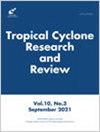预测眼壁更换周期的微波机器学习方法
IF 4.1
4区 地球科学
Q3 METEOROLOGY & ATMOSPHERIC SCIENCES
引用次数: 0
摘要
眼壁替换周期(ERCs)通过影响最大风速、风场大小和风暴潮严重程度,极大地增加了热带气旋(TC)的破坏性潜力,同时降低了对TC预报的信心,尤其是对强度预报的信心。机器学习(ML)为提高当前的预测和预测能力提供了新的机会,它的应用将使预报员和最终的公众受益。该项目的目标是创建一个概念验证的ML卷积神经网络(CNN),使用89 GHz微波频段进行训练和测试,以预测erc。训练集由北大西洋盆地(NATL) 1999 - 2009年的风暴组成。测试集包括2019年至2022年的NATL风暴。我们创建了12个模型,这些模型被称为CNN预测眼壁更换周期集合(CE-PERCY),每个模型的训练准确率至少达到80%。利用合成孔径雷达、陆基雷达、飞机侦察、基于微波的ERC概率(M-PERC)、国家飓风中心报告和微波图像,对测试集进行ERC分析。在2019年至2022年的14次飓风中发现了28个erc。CE-PERCY在概念验证中表现良好,版本a和B分别预测21和23个erc。该项目成功地为在ERC预测中使用ML cnn奠定了基础,证明了该技术的可行性,并证明了足够大的微波图像数据集可以用于该特定应用。本文章由计算机程序翻译,如有差异,请以英文原文为准。
A microwave-based machine learning approach for predicting eyewall replacement cycles
Eyewall replacement cycles (ERCs) greatly increase the destructive potential of tropical cyclones (TCs) by affecting the maximum wind speed, wind field size, and storm surge severity while simultaneously reducing confidence in TC forecasts, most prominently in intensity forecasting. Machine learning (ML) presents new opportunities to improve current forecasting and predictive capabilities, and its application will benefit forecasters and ultimately the public. The objective of this project was to create a proof-of-concept ML convolutional neural network (CNN) to predict ERCs using the 89 GHz microwave band for training and testing. The training set was comprised of North Atlantic basin (NATL) storms from 1999 to 2009. The testing set included NATL storms from 2019 to 2022. Twelve models were created, together known as the CNN Ensemble for Predicting Eyewall Replacement Cycles (CE-PERCY), with each individual member achieving at least 80 % in-training accuracy. Two versions were created: versions A and B. Using synthetic aperture radar, land-based radar, aircraft reconnaissance, Microwave-based Probability of ERC (M-PERC), National Hurricane Center reports, and microwave imagery, ERC analysis was conducted on the testing set. 28 ERCs were identified throughout 14 hurricanes from 2019 to 2022. CE-PERCY performs well for a proof-of-concept, with versions A and B predicting 21 and 23 ERCs, respectively. This project successfully introduces a foundation for using ML CNNs in ERC prediction, demonstrates the viability of the technique, and proves that a large enough dataset of microwave imagery can be used in this specific application.
求助全文
通过发布文献求助,成功后即可免费获取论文全文。
去求助
来源期刊

Tropical Cyclone Research and Review
METEOROLOGY & ATMOSPHERIC SCIENCES-
CiteScore
4.60
自引率
3.40%
发文量
184
审稿时长
30 weeks
期刊介绍:
Tropical Cyclone Research and Review is an international journal focusing on tropical cyclone monitoring, forecasting, and research as well as associated hydrological effects and disaster risk reduction. This journal is edited and published by the ESCAP/WMO Typhoon Committee (TC) and the Shanghai Typhoon Institute of the China Meteorology Administration (STI/CMA). Contributions from all tropical cyclone basins are welcome.
Scope of the journal includes:
• Reviews of tropical cyclones exhibiting unusual characteristics or behavior or resulting in disastrous impacts on Typhoon Committee Members and other regional WMO bodies
• Advances in applied and basic tropical cyclone research or technology to improve tropical cyclone forecasts and warnings
• Basic theoretical studies of tropical cyclones
• Event reports, compelling images, and topic review reports of tropical cyclones
• Impacts, risk assessments, and risk management techniques related to tropical cyclones
 求助内容:
求助内容: 应助结果提醒方式:
应助结果提醒方式:


